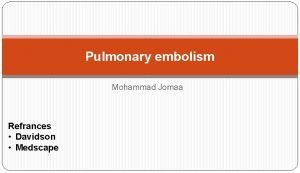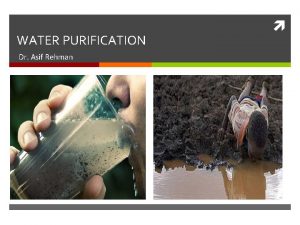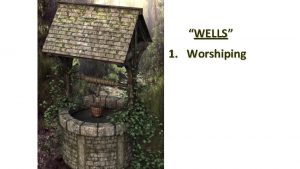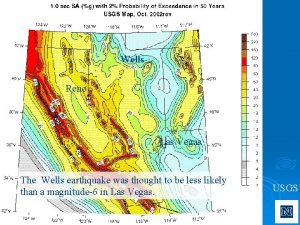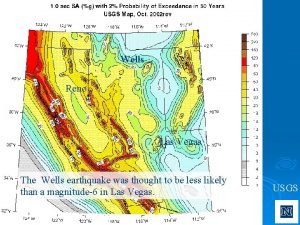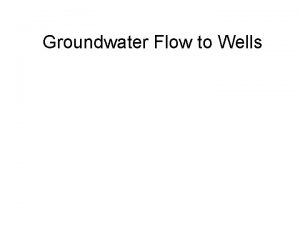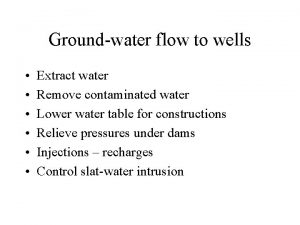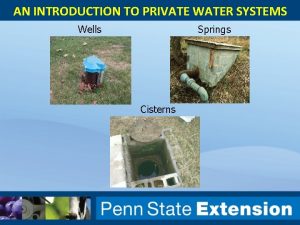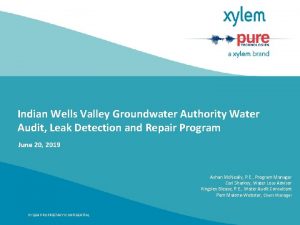Water Wells Unit 4 Water Wells A water






























- Slides: 30

Water Wells Unit 4

Water Wells �A water well is usually a vertical hole in the earth for bringing groundwater to the surface. �Some times water wells are used for other purposes as well such as ◦ subsurface exploration and observation, ◦ artificial recharge and ◦ disposal of waste water.

Water Wells �There are many methods for construction of wells. �The selection of a particular method depends on ØPurpose of the well ØQuantity of water required ØDepth to groundwater ØGeologic conditions and ØEconomic factors

Water Wells � Shallow wells are dug, bored, driven or jetted. � Deep wells are drilled by cable tool or rotary methods. � Attention to proper design can ensure efficiency and long life of the wells. � After the well has been drilled it should be completed, developed for optimum yield and tested. � Wells should be sealed against entrance of surface pollutants and should be given periodic maintenance.

Methods for construction of shallow wells �Shallow wells are generally less than 15 meters in depth and can be constructed by ØDigging (Dug Wells) ØBoring (Bored Wells) ØDriving or (Driven Wells) ØJetting (Jetted Wells)

Dug Wells � Depth of dug wells may go up to 20 meters or more depending upon the depth to water table and the diameter may vary from 1 to 10 meters. � Their large diameter helps in the storage of large quantities of water if their depth is some distance below the water table. � These wells are normally used for individual water supply mostly in areas having unconsolidated glacial or alluvial sediments. � Dug wells are mostly excavated by hand, however the use of blasting techniques may be employed while digging in hard rock formations. � The dug well may be just a hole in the ground or it may be lined with a casing of brick, rock, concrete or metal.

Dug Wells

Bored Wells � Where the water table exists at shallow depths in an unconsolidated aquifer , bored wells can furnish small quantities of water at minimal cost. � Bored wells are constructed with hand operated or power driven earth augers. � Hand-bored wells are rarely more than 15 meters in depth and 20 cm in diameter. � Power driven augers may go up to a depth of 30 meters and the diameter may be up to 1 meter. � The auger consists of a cylindrical steel bucket with a cutting edge projecting from a slot in the bottom. � The bucket is filled by rotating it in the hole by a drive shaft of adjustable length. � When the auger is full it is taken out of the hole and the excavated material

Bored Wells

Driven Wells � A driven well consists of a series of connected lengths of pipe driven by repeated impacts into the ground below the water table. � Water enters the well through a drive point at the lower end of the well. � Diameters of driven wells are small, mostly falling in the range of 3 to 10 cm. � Depths are generally less than 15 meters but few may exceed 20 meters. � The water is taken out from these wells by a suction pump, therefore the water table must be close to the ground surface for a continuous water supply. � For best results the water table should be within 3 to 5 meters depths from the ground. � Driven wells are best suited for domestics supply, for temporary water supply and for exploration and observation. � Driven wells are limited to unconsolidated formation containing no large boulder or gravel which might damage the drive point.

Driven Wells

Jetted Wells � Jetted wells are constructed by the cutting action of downward directed stream of water. � The high velocity stream washes the earth away, while the casing which is lowered into the deepening hole , conducts the water and cuttings up and out of the well. � Small diameter holes of 3 to 10 cm are formed in this manner and the depths may go up to 15 meters or more. � Jetted wells have small yields and are best suited for unconsolidated formations. � Because of the speed of jetting a well and the portability of the equipment , jetted wells are useful for exploratory test holes and observation wells.

Jetted Wells

Methods for construction of deep wells �Most large, deep and high-capacity wells are constructed by drilling. �The drilling can be done by cable-tool method or by one of the several rotary methods. �Each method has a particular advantage so experienced drillers have drilling equipments available for different drilling approaches.

Cable tool method � Wells drilled by cable tool method are constructed with a standard well drilling rig, percussion tools and bailer. � The method is capable of drilling holes of 8 to 60 cm in diameter through consolidated rock material to depths of 600 meters. � Drilling is accomplished by regular lifting and dropping of a string of tools. � On the lower end of the tool is a bit with sharp, chisel edge which breaks the rock by impact. � From top to bottom, a string of tools consists of a swivel socket, a set of jars, a drill stem and a drill bit. � The total weight of the tool may reach up to several thousand kilograms. � Tools are made up of steel and are joined to each other by box and pin screw joints.

Cable tool method � The most important part of the string of tools is the bit which actually does the drilling. � Drill cuttings are removed from the well by a bailer or sand bucket. � During frilling the tool makes 20 -40 strokes per minute, ranging from 40 to 100 cm in length. � After the bit has cut 1 to 2 meters of the formation, the string tool is lifted to the surface and the drill cuttings are removed. � The cable tool method is highly versatile and can be used for drilling in a variety of geologic conditions. � However the major drawbacks of the method are the slow drilling rate, its depth limitation, the need to put the casing along with the drilling in unconsolidated formations. � The simplicity of design and the ease of maintenance and repair of the rig and tools are important advantages in isolated areas.

Cable tool method

Rotary method � A rapid method of drilling in unconsolidated formation is the rotary method. � Deep wells up to 45 cm in diameter or more can be constructed using this method. � The method consists of a hollow rotating bit through which a mixture of clay and water or drilling mud is forced. � Materials drilled by the method is carried upward on the surface by the rising mud. � No casing is normally required as the mud forms a clay lining on the walls of the well thereby preventing collapse of the well. � Drill bits are available in different designs that grind and fracture through the rock. � The common string of tools consists of a drill bit, a drill collar (to add weight) and a drill pipe that extends up to the ground surface.

Rotary method � Drilling mud consists of a suspension of water, bentonite (clay) and other organic substance. � Rotary drilling is employed for oil wells and its application to water-well drilling is steadily increasing. � Advantages are the rapid drilling rate, the avoidance of placement of casing at the time of drilling. � Disadvantages include the high equipment cost, more complex operation and the need to remove the mud cake during well development

Air Rotary Method � Rotary drilling can also be accomplished with compressed air in place of drilling mud. � The technique is rapid and convenient for smalldiameter holes in consolidated formations where a clay lining is unnecessary to support the walls against caving. � Drilling depth can exceed 150 meters under favorable circumstances. � An important advantage of this method is its ability to drill through fissured rock formations with little or no water required.

Air Rotary Method

Rotary-Percussion Method �A recent developed rotary-percussion procedure using air as the drilling fluid provides the fastest method for drilling in hard rock formations. �A rotating bit, with the action of pneumatic hammer, delivers 10 to 15 impacts per second to the bottom of the hole. � Penetration rates can be as high as 30 cm/min. � Where caving formation or large quantities of water are encountered, a change to conventional rotary drilling with mud usually becomes necessary.

Rotary-Percussion Method

Well Completion � After the drilling has been finished, the well must be completed. This can include Ø Placement of casing Ø Cementing of casing Ø Placement of well screens and Ø Gravel packing � However wells in hard rock formations can be left as it is and these components may not be required

Well completion: Casing � Well casing serves as a lining to maintain an open hole from the ground surface to the aquifer. � It prevents the surface water to enter the well and also protects the wall of the well from collapsing. � The common material used for casing include wrought iron, steel and PVC pipes. � Casings can further be divided into 2 types ◦ Surface casing and ◦ Pump chamber casing

Well completion: Casing �Surface casing is installed from the ground surface through the upper strata of the unstable, weathered or fractured material into relatively stable material. �Pump chamber casing comprises all casing above the screen in wells of uniform

Well completion: Cementing �The space left between the bored hole and the casing is normally filled with cement to prevent the corrosion of the casing and to stabilize the caving rock formation. �The cement grout consists of a mixture of cement and water and can be placed by a dump bailer or by pumping.

Well completion: Screens � In consolidated formations where the material surrounding the well is stable, groundwater can directly enter an uncased well. � In unconsolidated formation however wells are equipped with screens. � The screen stabilizes the side of the hole, prevents sand movement in the well and allows the maximum amount of water to enter the well. � Screens are available in a range of diameters and the selection of the screen diameter should be made on the basis of desired well yield and aquifer thickness.

Well completion: Gravel packs �A gravel packed well is one containing an artificially placed gravel screen or envelope surrounding the well screen. �A gravel pack stabilizes the aquifer, minimizes sand pumping, permits use of a large screen slot with a maximum open area and provides an annular zone of high permeability which increases the effective radius and yield of the well.

Well development �After the well has been completed, it must be developed to increase its specific capacity and obtain maximum economic well life. �These results are obtained by removing the finer material from the natural formations surrounding the perforated sections of the casing. �Development procedure are varied and include pumping, surging, use of compressed air hydraulic jetting, addition of chemicals, hydraulic fracturing and use of explosives.
 Water and water and water water
Water and water and water water Wells water systems recently reported
Wells water systems recently reported Unit 10, unit 10 review tests, unit 10 general test
Unit 10, unit 10 review tests, unit 10 general test Unit 11 water water everywhere
Unit 11 water water everywhere Pfil collins
Pfil collins Wells fargo social responsibility
Wells fargo social responsibility Define wholesome water
Define wholesome water Sonrise lite
Sonrise lite Wells skoru
Wells skoru Criterios wells
Criterios wells Allocation wells in texas
Allocation wells in texas Purification of water on large scale storage
Purification of water on large scale storage Pte tanı algoritması
Pte tanı algoritması Thrombus embolus
Thrombus embolus Modèle de stackhouse et wells
Modèle de stackhouse et wells Wells fargo merchant service
Wells fargo merchant service Criterios de wells
Criterios de wells How to tell wild animals
How to tell wild animals Wells fargo budget worksheet
Wells fargo budget worksheet Vocational rehabilitation georgia
Vocational rehabilitation georgia Hmruc
Hmruc Escore de wells
Escore de wells Score wells ep
Score wells ep Score de wells
Score de wells Wells fargo hierarchy
Wells fargo hierarchy Wells rectopexy
Wells rectopexy Wells church furniture
Wells church furniture Double pot method water purification
Double pot method water purification Wells fargo identity theft repair kit
Wells fargo identity theft repair kit Score caprini modificado
Score caprini modificado Lauren wells chests
Lauren wells chests













